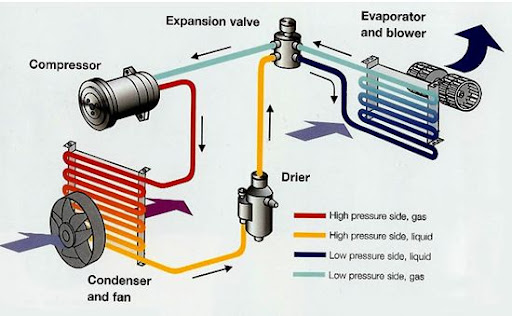Atmosphere always contains water vapour
Owing to evaporation which goes on continuously from the sea and other water surfaces, the atmospher always contains water vapour. The quantity of vapour which air can hold depends on the temperature.
If warm air containing water vapour is cooled it can hold less vapour, so that below a certain temperature the excess vapour condenses out.
Moisture on a spectacle. What is the dew point?
Those who wear spectacles know that when they enter a warm room from the cold outside air a film of moisture is often deposited on the spectacle lenses.
Similarly, a cold mirror may become dulled when brought into a warm atmosphere.
In such cases the cold glass surface cools the air in its vicinity to a temperature below that for which the water vapour present is sufficient to saturate the air. Excess vapour then condenses out, and the highest temperature at which this can occur is called the dew point.
The dew point is defined as the temperature at which the water vapour present in the air is just sufficient to saturate it.
Relative humidity formula
On discussing cooling produced by evaporation we mentioned the part played by prespiration in controlling bodily temperature. We shall now look into this a little more fully.
The rate at which moisture evaporates from the sjin depends on three factors, namely,
1- the temperature,
2- the amount of water vapour present in the atmosphere and.
3- the rate of movement of air over the skin.
On this occasions when the air is still and its vapour content is near to saturation the rate of evaporation from the body slows up. Under theses conditions even moderate exercise induces profuse perspiration, and the skin remains moist or clammy.
The atmosphere is described as being close or humid. Matters can be improved if the rate of evaporation is increased by setting the air in motion. Where there is no natural breeze an artificial one can be created by fans. This is often done in rooms where humid conditions frequently occur.
At other times, when the air is comparatively dry, evaporation from the skin takes place more easily, and faster cooling of the body ensues. Thus, in hot continental climates, where the atmosphere tends to be dry, high temperatures can be tolerated more comfortably than in tropical regions, where heavily rainfall leads to near-saturation conditions.
From this point of view of personal comfort and for certain industrial purposes, the actual quantity of water vapour present in the air is not so important as its nearest to saturation or relative humidity.
Relative humidity = mass of water vapour in a given volume of air / mass of water vapour required to saturate the same volume of air at the air temperature
.
This ratio may also be expressed in the more convenient form.
Relative humidity = s.v.p. of water at the dew point / s.v.p. of water at the original air temperature
There are a number of different methods available for measuring relative humidity by instruments called hygrometeres. We shall describe one of the simpler and more common types in use.
wet and dry-bulb hygrometer:

Wet and dry-bulb hygrometer
For meteorological purposes the relative humidity may be measured quickly with a reasonable degree of accuracy by means of the wet and dry-bulb hygrometer. This instrument has two thermometers mounted side by side, one of which has its bulb covered with a muslin wick dipping into a small vessel of water.
Owing to evaporation of water from the muslin, the wet bulb is cooled to an extent which depends on the dryness of the surrounding air. Tables have been drawn up relating the relative humidity to the dry-bulb temperature and the wet-bulb depression.
Humidity control
In certain manufacturing processes the relative humidity is an important factor. Cotton fibres, for example, must not become too dry, or they become brittle and difficulties arise through electrification by friction. For this reason the British cotton spinning industry came to be established in the damp climate of Lancashire on the west side of Pennines. In this part of the country moisture-laden winds from the Atlantic are forced upwards over the high ground where the atmospheric pressure is less. In the resulting expansion the air does work, and the energy for this is provided from the internal energy of the air. Consequently, the wind cools and excess moisture is precipitated as rain.
In contrast, a dry atmosphere is needed in factories where the assembly of certain electrical components is carried out. This requirement also applies to warehouses for the storage of food and for the seasoning of wood. In such cases special equipment is installed to dry the air and recirculate it through the building.
Air conditioning
Air conditioning diagram:

At the present time increasing use is being made of air-conditioning plant in ships, theatres, concert halls and other buildings. Large fans draw air from outside and pass it through water sprays to wash out dust and fog particles. Afterwards it is heated and humidified to the correct value before being conveyed through large pipes or ducts to the various rooms.
